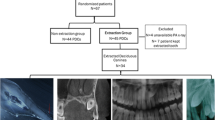Abstract
Ten orthodontists were asked to diagnose the number of impacted upper canines and the number of resorbed lateral and/or central incisor roots in 30 panoramic radiographs (P1) from 30 patients. In order to objectify these diagnoses, transversal CT images of all 30 patients were examined in addition.
Addition of the recordings in the 30 patients revealed that the 10 orthodontists had diagnosed 350 impacted/displaced canines. On comparison of the P1 and CT results, the latter revealed that, in fact, 390 canines were impacted or displaced, not just 350. Addition of the recordings further showed that, based on P1, the investigators had diagnosed 73 resorptions in the 1,200 incisors examined. However, the CT showed 160 resorptions; this corresponds to a sensitivity value of 45.6%. The CT showed 1,040 incisors with no resorptions, whereas the investigators diagnosed only 925, teeth as not resorbed in the P1. The specificity was thus 88.9%.
These results show that, due to their low reliability, panoramic radiographs are not an appropriate means of diagnosing resorptions in front teeth in connection with impacted canines.
Zusammenfassung
An 30 Panoramaaufnahmen (P1) von 30 Patienten sollten von zehn Kieferorthopäden die Anzahl retinierter oberer Eckzähne sowie die Anzahl resorbierter seitlicher und/oder mittlerer Schneidezahnwurzeln angegeben werden. Für eine Objektivierung dieser Diagnosen standen uns dazu von allen 30 Patienten transversale CT-Schnittbilder zur Verfügung.
Beim Addieren der Befunde von den 30 Patienten diagnostizierten die zehn Kieferorthopäden 350 retinierte/verlagerte Eckzähne. Bei einem Vergleich dieser Befunde anhand der P1 und der CT hätten 390 Eckzähne retiniert/verlagert sein müssen und nicht nur 350. Das Addieren der Befunde anhand der P1 zeigte weiterhin, daß von 1 200 Schneidezähnen nur 73 als resorbiert beurteilt wurden. Nach der Beurteilung der CT waren es aber 160 Resorptionen. Die Werte für die Sensitivität betrugen demnach 45,6%. Von den 1 040 Schneidezähnen, die laut CT keine Resorption aufwiesen, erkannten die Untersucher nur 925 als nicht resorbiert. Somit betrug der Wert für die Spezifität 88,9%.
Die Ergebnisse zeigten, daß infolge zu geringer Zuverlässigkeit die Panoramaschichtaufnahme nicht zur Diagnostik von Wurzelresorptionen an Schneidezähnen durch retinierte Eckzähne geeignet ist.
Similar content being viewed by others
References
Blindhofer R, Freudenthaler JW, Millesi W, et al. Der Einsatz der Computertomographie in der Diagnostik verlagerter Zähne. Eine retrospektive Evaluierung ihrer Aussagekraft. Stomatologie 1997;94:281–90.
Clark DE, Danforth RA, Barnes RW, et al. Radiation absorbed dose from dental implant radiography: A comparison of linear tomography, CT-scan, and panoramic and intraoral technique. J Oral Implantol 1990;16:156–64.
Dausch-Neumann D. Der Durchbruchsweg bleibender Eckzähne. Fortschr Kieferorthop 1970;31:9–16.
Diedrich P. Die kieferorthopädische Einordnung retinierter Zähne. Dtsch. Zahnärztekalender. München: Hanser, 1986: 84–101.
Elefteriadis JN, Athanasiou AE. Evaluation of impacted canines by means of computerized tomography. Int J Adult Orthod Orthognath Surg 1996;11:257–64.
Ericson S, Kurol J. Radiographic assessment of maxillary canine eruption in children with clinical signs of eruption disturbance. Eur J Orthod 1986;8:133–40.
Ericson S, Kurol J. Radiographic examination of ectopically erupting maxillary canines. Am J Orthod Dentofac Orthop 1987;91:483–92.
Fezoulidis I, Schadlbauer E, Traxler M, et al. Retinierte und verlagerte Zähne in der Computertomographie. Fortschr Röntgenstr 1989;151:729–32.
Frederiksen ML, Benson BW, Sokolowski TW. Effective dose and risk assessment from computed tomography of the maxillofacial complex. Dentomaxillofac Radiol 1995;24:55–8.
Harzer W, Seifert D, Mahdi Y. Die kieferorthopädische Einordnung retinierter Eckzähne unter besonderer Berücksichtigung des Behandlungsalters, der Angulation und der dynamischen Okklusion. Fortschr Kieferorthop 1994;55:47–53.
Hirschfelder K, Hirschfelder H. Einsatzmöglichkeiten der Computertomographie in der Kieferorthopädie“-erste Erfahrungen. Dtsch Zahnärztl Z 1984;39:939–46.
Hirschfelder K, Petschelt A. Retention von Zähnen aus kieferorthopädischer Sicht. Dtsch Zahnärztl Z 1986;41:164–70.
Komposch G, Anhalt H. Die kieferorthopädische Einordnung verlagerter Zähne-Indikation, Technik und Ergebnisse. Dtsch Zahnärztl Z 1987;42:162–6.
Peene P, Lamoral Y, Plas H, et al. Resorption of the lateral maxillary incisor: Assessment by CT. J Comput Assist Tomogr 1990;14:427–9.
Reitan K. In: Graber TM, Swain BF. Grundlagen und moderne Techniken der Kieferorthopädie, Kap. 2. Berlin-Chicago-London-Sao Paulo-Tokio: Quintessenz, 1989:149–270.
Schmuth GPF, Freisfeld M, Köster O, et al. The application of computerized tomography (CT) in cases of impacted maxillary canines. Eur J Orthod 1992;14:296–301.
Schüller H, Köster O, Ewen K. Untersuchung zur Strahlenbelastung von Augenlinse und Schilddrüse bei der hochauflösenden Computertomographie der Zähne. Fortschr Röntgenstr 1992;156:189–92.
Schüller H, Freisfeld M. Die Schädigung bleibender Zähne durch verlagerte obere Eckzähne. Fortschr Röntgenstr 1992;157:107–10.
Author information
Authors and Affiliations
Rights and permissions
About this article
Cite this article
Freisfeld, M., Dahl, I.A., Jäger, A. et al. X-ray diagnosis of impacted upper canines in panoramic radiographs and computed tomographs. J Orofac Orthop/Fortschr Kieferorthop 60, 177–184 (1999). https://doi.org/10.1007/BF01365264
Received:
Accepted:
Issue Date:
DOI: https://doi.org/10.1007/BF01365264




